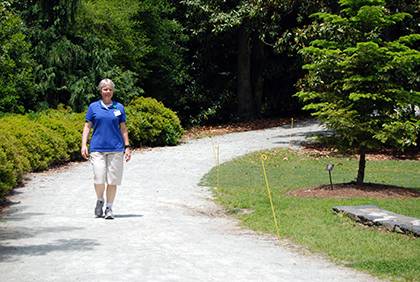Make Your Steps Count
Walking is an easy way to burn calories and earn rewards at Duke

Personal health and fitness have always been important to Sarah Woodring, which is why she takes 30 minutes during lunch to walk on campus near her office in the Preston Robert Tisch Brain Tumor Center.
Most days, that means walking to Sarah P. Duke Gardens, where she traverses gravel walkways that wind throughout the iconic green space. For her, walking is an important part of her day and an easy way to burn calories while resetting her state of mind.
Read More"My office is down in a basement with no windows, so if I don't get out to walk during my lunch break, I could go all day without seeing sunlight," said Woodring, who walks for about 30 minutes during lunch and after work, too. "It keeps me mentally fresh."
Wooding is one of about 500 Duke employees who participates in Take Ten, a self-paced program that guides participants through five levels of strength and stretching exercises, such as wall push-ups and arm, leg and neck stretches. Each level involves completing an increasing number of repetitions of stretches. Take Ten allows participants to track daily walks, too.
That's important, said Liz Grabosky, fitness manager with LIVE FOR LIFE, Duke's employee wellness program that administers Take Ten. In recent years, walking habits of Americans have lagged behind other countries around the world. A study from Medicine & Science in Sports & Exercise shows residents in places like Australia, Switzerland and Japan take almost twice as many steps as the 5,117 Americans average each day.
Grabosky noted that an ideal number of daily steps is 10,000, the equivalent of roughly five miles. She said that's hard for many people because a sedentary lifestyle can be considered normal, even if it may lead to obesity and weight-related health problems like high blood pressure. Even at a leisurely pace, Grabosky said walking for one hour can burn up to about 400 calories.
"Lack of movement is something we should fight every day," she noted. "That's why LIVE FOR LIFE programs are geared toward reminding and encouraging Duke employees to get up and go."
Popular places to walk at Duke include the track around East Campus, the Wallace Wade Stadium track, Al Buehler Cross Country Tail and Woodring's favorite - nearly five miles of paths that run throughout Duke Gardens.
By logging activity in Take Ten, participants may earn up to 260 LIVE FOR LIFE dollars, which can be used to buy a variety of fitness and kitchen items from the LIVE FOR LIFE store. Faculty and staff can also sign up for Take the Stairs, a stair-stepping program that rewards employees for logging the number of stairs they climb each day.
Woodring has taken advantage of both programs, earning LIVE FOR LIFE dollars to purchase items like a fleece jacket, dumbbells and even massages.
"It's a nice bonus to work toward," she said.
Ultimately, the accountability of tracking her effort and reporting her numbers confidentially to LIVE FOR LIFE has helped keep Woodring focused on good health.
"I make myself get out the door because it's a conscious thing, knowing I need to track what I'm doing," she said. "If I weren't tracking, I'd be less likely to push myself."